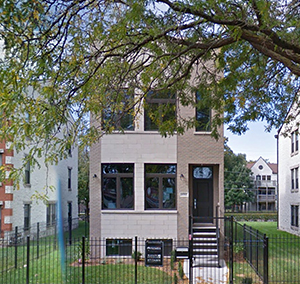Lifelong Brooks Family Residence

Google Map image, 2017
The child of David Brooks, a janitor, and Keziah Wims Brooks, a former schoolteacher, Gwendolyn Brooks was born in her grandmother’s house in 1917 in Topeka, Kansas, but moved to the South Side of Chicago within three months after her birth. When Brooks was four, the family moved to their permanent home at 4332 Champlain Avenue. The Brooks were the second black family on this short block (cut off from the main traffic). It was a changing neighborhood that would soon see an increasing number of African American residents and eventually African American institutions. Here there were playmates, a front and a back yard, a porch, a hammock, and a sandbox, according to D.H. Malhem, in Gwendolyn Brooks: Poetry and the Heroic Voice.
Brooks’ home life was characterized by “a quick-walking, careful Duty-Loving mother, who played the piano, made fudge, made cocoa and prune whip and apricot pie, drew tidy cows and trees and expert houses with chimneys and chimney smoke, who helped her children with arithmetic homework, and who sang” as stated by biographer, Elizabeth Schroeder Schlabach. Gwendolyn herself, though young and excitable, still found solace in the quiet time she spent within her own room, the hours she spent daydreaming in the yard, playing with paper dolls, reading, writing, and drawing according to another well-known biographer of Brooks’ legacy, George Kent.
At this home, according to Kent, Gwendolyn gave herself to writing poetry. She started rhyming as early as her seventh year, and with her mother practiced public delivery. At age 11, she began keeping notebooks of the poetry she had written, musings on nature, love, death, and much more. Surviving collections extend from her 13th year to her 25th, with the exception of 1932. Brooks wrote in her memoir, Report From Part One, that she “dreamed freely, often on the top step of the back porch.” At the age of 13, in 1930, Brooks’ poem, “Eventide” was published nationally in American Childhood. On August 18, 1934, the 17-year-old Gwendolyn had her poem, “To the Hinderer” published in the Chicago Defender. Throughout the next four years, 75 of Brooks’ poems were featured in the Chicago-based publication.
Brooks’ early poetry attempts were the result of voracious reading, including Anne of Green Gables and the poet Paul Lawrence Dunbar. Early on, Brooks’ father David read to her stories from the Harvard Classics. Her mother Keziah would write songs for her children, and also commissioned Gwendolyn to write plays for a children’s church group she led. Both parents greatly encouraged their daughter’s ambitions, and once they recognized her burgeoning talents relieved her of many household chores to free up her time for these more intellectual pursuits.
Brooks’ narratives of the struggles and triumphs of poorer African American families on Chicago’s South Side reflect her humble beginnings. Her focus on African American mothers was inspired by her own idea of home and motherhood. It was this residence, along with a later second-floor apartment at which she lived, from which Brooks drew inspiration for her collection, A Street in Bronzeville.
In Maud Martha, she wrote, “I think I’ll give a party. I haven’t given a party since I was eleven. I’d like some of my friends to just casually see that we’re homeowners.”
Brooks said that her reputation was bolstered by a review of Bronzeville in the Chicago Tribune by Paul Engle, a poet and founder of the Iowa Writers School. Engle maintained that her poems were no more "Negro poetry" than Robert Frost's poetry was "white poetry."
After graduating from Woodrow Wilson Junior College in 1936, Gwendolyn Brooks’ involvement with the NAACP began while still living in this very house. According to Kent, Brooks met Henry Blakely Jr. at a meeting at the YWCA at Forty-Sixth and South Park, and the young couple soon began a year-long courtship. In 1939, Blakely Jr. and Brooks married in the living room of this family home.
Nora Brooks Blakely, born in 1951, had planned to make this house into a small arts center in tribute to her parents before the building was tragically destroyed by fire in September 1984. Though the house has been rebuilt and resold since then and lacks a landmark status, the Chicago Park District renamed Hyacinth Park in honor of Gwendolyn Brooks, as it is approximately a mile away from her childhood home.
The child of David Brooks, a janitor, and Keziah Wims Brooks, a former schoolteacher, Gwendolyn Brooks was born in her grandmother’s house in 1917 in Topeka, Kansas, but moved to the South Side of Chicago within three months after her birth. When Brooks was four, the family moved to their permanent home at 4332 Champlain Avenue. The Brooks were the second black family on this short block (cut off from the main traffic). It was a changing neighborhood that would soon see an increasing number of African American residents and eventually African American institutions. Here there were playmates, a front and a back yard, a porch, a hammock, and a sandbox, according to D.H. Malhem, in Gwendolyn Brooks: Poetry and the Heroic Voice.
Brooks’ home life was characterized by “a quick-walking, careful Duty-Loving mother, who played the piano, made fudge, made cocoa and prune whip and apricot pie, drew tidy cows and trees and expert houses with chimneys and chimney smoke, who helped her children with arithmetic homework, and who sang” as stated by biographer, Elizabeth Schroeder Schlabach. Gwendolyn herself, though young and excitable, still found solace in the quiet time she spent within her own room, the hours she spent daydreaming in the yard, playing with paper dolls, reading, writing, and drawing according to another well-known biographer of Brooks’ legacy, George Kent.
At this home, according to Kent, Gwendolyn gave herself to writing poetry. She started rhyming as early as her seventh year, and with her mother practiced public delivery. At age 11, she began keeping notebooks of the poetry she had written, musings on nature, love, death, and much more. Surviving collections extend from her 13th year to her 25th, with the exception of 1932. Brooks wrote in her memoir, Report From Part One, that she “dreamed freely, often on the top step of the back porch.” At the age of 13, in 1930, Brooks’ poem, “Eventide” was published nationally in American Childhood. On August 18, 1934, the 17-year-old Gwendolyn had her poem, “To the Hinderer” published in the Chicago Defender. Throughout the next four years, 75 of Brooks’ poems were featured in the Chicago-based publication.
Brooks’ early poetry attempts were the result of voracious reading, including Anne of Green Gables and the poet Paul Lawrence Dunbar. Early on, Brooks’ father David read to her stories from the Harvard Classics. Her mother Keziah would write songs for her children, and also commissioned Gwendolyn to write plays for a children’s church group she led. Both parents greatly encouraged their daughter’s ambitions, and once they recognized her burgeoning talents relieved her of many household chores to free up her time for these more intellectual pursuits.
Brooks’ narratives of the struggles and triumphs of poorer African American families on Chicago’s South Side reflect her humble beginnings. Her focus on African American mothers was inspired by her own idea of home and motherhood. It was this residence, along with a later second-floor apartment at which she lived, from which Brooks drew inspiration for her collection, A Street in Bronzeville.
In Maud Martha, she wrote, “I think I’ll give a party. I haven’t given a party since I was eleven. I’d like some of my friends to just casually see that we’re homeowners.”
Brooks said that her reputation was bolstered by a review of Bronzeville in the Chicago Tribune by Paul Engle, a poet and founder of the Iowa Writers School. Engle maintained that her poems were no more "Negro poetry" than Robert Frost's poetry was "white poetry."
After graduating from Woodrow Wilson Junior College in 1936, Gwendolyn Brooks’ involvement with the NAACP began while still living in this very house. According to Kent, Brooks met Henry Blakely Jr. at a meeting at the YWCA at Forty-Sixth and South Park, and the young couple soon began a year-long courtship. In 1939, Blakely Jr. and Brooks married in the living room of this family home.
Nora Brooks Blakely, born in 1951, had planned to make this house into a small arts center in tribute to her parents before the building was tragically destroyed by fire in September 1984. Though the house has been rebuilt and resold since then and lacks a landmark status, the Chicago Park District renamed Hyacinth Park in honor of Gwendolyn Brooks, as it is approximately a mile away from her childhood home.








